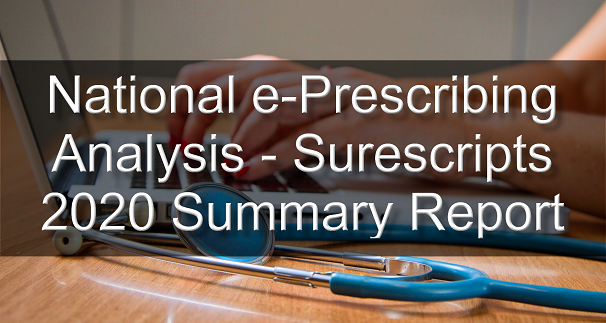

----- Blog Index / National e-Prescribing Analysis with Data from Surescripts (2020 Report) [MDToolbox Staff] [2021-05-06]

Surescripts has released their 2020 National Progress Report which details the current state of electronic prescribing in the United States. Surescripts is a health information network hub that digitally connects healthcare providers to pharmacies and PBMs/insurance companies. Surescripts is privately owned by the National Association of Chain Drug Stores (NACDS), National Community Pharmacists Association (NCPA), CVS Health and Express Scripts.
The report began by sharing some harsh statistics for how 2020 affected some practices. During the first peak of the pandemic, ambulatory care visits dropped by 60%. By the end of the year, 8% of US practices had permanently closed. As we saw with a few clients, the pandemic helped push some providers into retirement. The graph below shows how the pandemic has influenced the number of active prescribers per month, a drop in active providers in April with the first wave of COVID-19 and then a steady rise through the end of the year. The number of active electronic prescribers broken 1 million for the first time in part due to the rise in popularity (and necessity) of telemedicine and the need to have prescriptions sent electronically.
Active Prescribers by Month – Surescripts 2020 National Progress Report
Surescripts processed 1.91 BILLION prescriptions in 2020, here are some selections of statistics from the report:
Rate of e-Prescribing – Surescripts 2020 National Progress Report
Rate of e-prescribing – Surescripts 2020 National Progress Report
Non-controlled substance e-prescribing rates rose three percent, while EPCS rose a remarkable 20% in 2020! This number likely rose dramatically not only due to the pandemic, but also the seven states that mandated electronic prescribing in 2020. As states continue to mandate e-prescribing of controlled substances, this number will continually rise. Currently, 37 states have enacted or pended legislation for electronic prescribing mandates.

E-Prescribing Utilization Among Prescibers – Surescripts 2020 National Progress Report
Prescriber utilization of e-prescribing has steadily risen every year, hitting 84% in 2020. Nearly all pharmacies in the US are utilizing e-prescribing. Our EPCS page has a table displaying pharmacies enabled for EPCS in every state. While the numbers of pharmacies slightly trend down; likely from smaller pharmacies closing, the percentage of those enabled for EPCS continue to rise.
Rate of e-prescribing by State – Surescripts 2020 National Progress Report
The above graph compares EPCS enablement throughout the 2020 calendar year in some States with current mandates (NY, VA, MN, NC), some states with mandates that are pending (CO, CA, MD), and a few states with no current mandate (HI, OH, NE, OR). Nebraska, Ohio, and Oregon (which do not have a current mandate) surpassed several states with pending and current mandates. Prior to 2020, Hawaii was the state with the lowest prescriber EPCS enablement. Their massive jump at the end of 2020 from 7.6% to 36.2%, surpassing Alabama which is currently the state with the lowest prescriber enablement. Surescripts attributed this sudden rise with the fact that several major health networks in Hawaii switched to electronic prescribing.
Check out our State map page for a look at the current status of electronic prescribing mandates for the entire country. Bookmarking our blog is another great way to keep up with these changes in legislation.
Rate of RTPB – Surescripts 2020 National Progress Report
The report also details an increase in the number of real-time prescription benefit checks. Real-time prescription benefit allows prescribers to check the patient cost for medications at the patient’s pharmacy in real-time, saving patients an average of $50 for a standard family practice visit. This advanced feature has been included with MDToolbox since 2018.
The increase in usage of Electronic Prescribing throughout the US means better protections for both prescribers and patients. For a prescriber it means there is less chance of fraud and abuse through prescribing, for a patient it means greater convenience by not having to keep track of paper prescriptions, better security for their personal information, and seeing a prescriber that can save them money on prescription drugs. We look forward to working with providers throughout the US to ease the transition and help provide tools and resources in combating the opioid epidemic. With MDToolbox, providers have access to tools such as Electronic Prescribing of Controlled Substances (EPCS) and convenient on the go mobile e-prescribing. Contact us for more information or to start your free 30 day free trial.